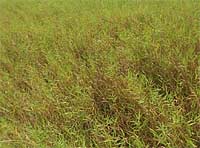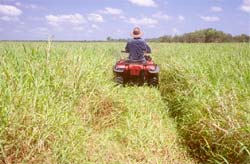Activity 4.1: Para Grass
| Taxonomic Name: | Urochloa mutica |
| Ecological Category: | Plant |
 Para grass, a perennial stoloniferous grass from Africa, was introduced
to Australia in 1884 to control river bank erosion, but has since been
widely promoted as a pasture grass throughout northern Australia.
Para grass, a perennial stoloniferous grass from Africa, was introduced
to Australia in 1884 to control river bank erosion, but has since been
widely promoted as a pasture grass throughout northern Australia.
It is considered a weed outside pastoral systems, and its aggressive invasion of tropical wetlands has lead to its listing among the 18 environmental weeds having potential to cause serious impact on a nationally significant scale.
 In
the early 1900’s, para grass was introduced as a pasture grass to
the area now recognised as Kakadu National Park. By the early 1990s, it
was identified as a species with fairly limited distribution within the
Park, but with the capacity to dominate large areas of relatively undisturbed
plant communities. With the removal of buffalo it has increased in distribution
and now covers large areas of floodplain, mostly on the Magela Creek and
East Alligator River systems. It can displace native vegetation thereby
reduce resources for native wildlife. Park managers are concerned about
its continued spread and have attempted to use herbicide and fire to control
it, but success has been variable.
In
the early 1900’s, para grass was introduced as a pasture grass to
the area now recognised as Kakadu National Park. By the early 1990s, it
was identified as a species with fairly limited distribution within the
Park, but with the capacity to dominate large areas of relatively undisturbed
plant communities. With the removal of buffalo it has increased in distribution
and now covers large areas of floodplain, mostly on the Magela Creek and
East Alligator River systems. It can displace native vegetation thereby
reduce resources for native wildlife. Park managers are concerned about
its continued spread and have attempted to use herbicide and fire to control
it, but success has been variable.
